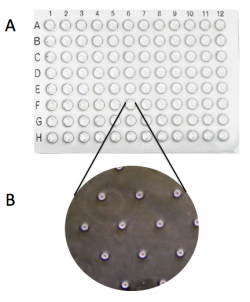Difference between revisions of "20.109(F16):Test comet chip loading variables (Day2)"
From Course Wiki
Noreen Lyell (Talk | contribs) (→Part 1: Design experiment to optimize comet chip loading) |
Noreen Lyell (Talk | contribs) (→Part 1: Design experiment to optimize comet chip loading) |
||
| Line 17: | Line 17: | ||
#How many cells should be loaded into each microwell? | #How many cells should be loaded into each microwell? | ||
| − | #*Consider the amount of DNA that is carried by a single mammalian cell and the detection limit provided by the SYBR gold DNA stain that will be used in your experiments. | + | #*Consider the amount of DNA that is carried by a single mammalian cell and the detection limit provided by the SYBR gold DNA stain that will be used in your experiments. Also, use the data you collected during the Orientation exercise to determine how many cells can fit into a single microwell based on the dimensions provided above. |
#* | #* | ||
#How many cells should be added to each well such that the desired number of cells are loaded into the microwells? | #How many cells should be added to each well such that the desired number of cells are loaded into the microwells? | ||
| + | #*Consider the likelihood that every cell you add to the well will fall into a microwell. Perhaps calculate the surface area of the bottom of a well and compare this to the size of the cells as you consider this question. | ||
| + | #* | ||
'''Experiment 2: Loading time''' | '''Experiment 2: Loading time''' | ||
Revision as of 18:46, 30 June 2016
Contents
Introduction
experimental design...
Protocols
Part 1: Design experiment to optimize comet chip loading
You will design two experiments that test variables associated with loading cells into the microwells of your comet chip. In the first experiment you will consider the role of cell number. Specifically, how many cells should be added to each well to ensure the majority of the microwells are loaded? In addition, how many cells should be loaded into each microwell? The second experiment will interrogate the length of time needed for loading.
Experiment 1: Cell number
- How many cells should be loaded into each microwell?
- Consider the amount of DNA that is carried by a single mammalian cell and the detection limit provided by the SYBR gold DNA stain that will be used in your experiments. Also, use the data you collected during the Orientation exercise to determine how many cells can fit into a single microwell based on the dimensions provided above.
- How many cells should be added to each well such that the desired number of cells are loaded into the microwells?
- Consider the likelihood that every cell you add to the well will fall into a microwell. Perhaps calculate the surface area of the bottom of a well and compare this to the size of the cells as you consider this question.
Experiment 2: Loading time
Part 2: Load comet chip
Reagents
Next day: [[
Previous day: Prepare comet chips
